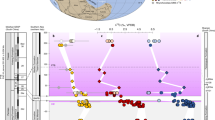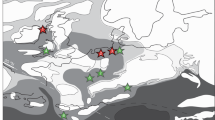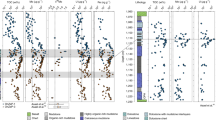Abstract
The evolution of complex life over the past 600 million years was disrupted by at least five mass extinctions, one of which occurred at the close of the Triassic period. The end-Triassic extinction corresponds to a period of high atmospheric-CO2 concentrations caused by massive volcanism and biomass burning; most extinction scenarios invoke the resulting environmental perturbations in accounting for the loss of marine and terrestrial biodiversity. Here we reconstruct changes in Tethyan shallow marine ecosystems and ocean redox chemistry from earliest Jurassic (Hettangian)-aged black shales from Germany and Luxemburg. The shales contain increased concentrations of the biomarker isorenieratane, a fossilized pigment from green sulphur bacteria. The abundance of green sulphur bacteria suggests that the photic zone underwent prolonged periods of high concentrations of hydrogen sulphide. This interval is also marked by the proliferation of green algae, an indicator of anoxia. We conclude that the redox changes in the entire water column reflect sluggish circulation in marginal regions of the Tethys Ocean. We suggest that the resultant repeated poisoning of shallow epicontinental seas—hotspots of Mesozoic biodiversity—with hydrogen sulphide may have slowed the recovery of marine ecosystems during the Early Jurassic.
This is a preview of subscription content, access via your institution
Access options
Subscribe to this journal
Receive 12 print issues and online access
$259.00 per year
only $21.58 per issue
Buy this article
- Purchase on Springer Link
- Instant access to full article PDF
Prices may be subject to local taxes which are calculated during checkout



Similar content being viewed by others
References
Sepkoski, J. J. Jr in Global Events and Event Stratigraphy in the Phanerozoic (ed. Walliser, O.H.) 35–51 (Springer, 1996).
Kiessling, W., Aberhan, M., Brenneis, B. & Wagner, P. J. Extinction trajectories of benthic organisms across the Triassic–Jurassic boundary. Palaeogeogr. Palaeoclimatol. Palaeoecol. 244, 201–222 (2007).
Whiteside, J. H. & Ward, P. D. Ammonoid diversity and disparity track episodes of chaotic carbon cycling during the early Mesozoic. Geology 39, 99–102 (2011).
Carter, E. S. & Hori, R. S. Global correlation of the radiolarian faunal change across the Triassic–Jurassic boundary. Can. J. Earth Sci. 42, 777–790 (2005).
Greene, S. E., Martindale, R. C., Ritterbush, K. A., Bottjer, D. J., Corsetti, F. A. & Berelson, W. M. Recognising ocean acidification in deep time: An evaluation of the evidence for acidification across the Triassic–Jurassic boundary. Earth Sci. Rev. 113, 72–93 (2012).
Ward, P. D. et al. Sudden productivity collapse associated with the Triassic–Jurassic boundary mass-extinction. Science 292, 1148–1151 (2001).
Van de Schootbrugge, B. et al. End-Triassic calcification crisis and blooms of organic-walled disaster species. Palaeogeogr. Palaeoclimatol. Palaeoecol. 244, 126–141 (2007).
Falkowski, P. G. et al. The evolution of modern eukaryotic phytoplankton. Science 305, 354–360 (2004).
Clemence, M-E. et al. Early Hettangian benthic-planktonic coupling at Doniford (SW England): Palaeoenvironmental implications for the aftermath of the end-Triassic crisis. Palaeogeogr. Palaeoclimatol. Palaeoecol. 295, 102–115 (2010).
Falkowski, P. G., Schofield, O., Katz, M. E., van de Schootbrugge, B. & Knoll, A.H. in Coccolithophorids: From Global Impact to Molecular Processes (eds Thierstein, H. R. & Young, J. R.) 429–453 (2004).
Lund, J. J. Rhaetian to Pliensbachian palynostratigraphy of the central part of the NW German Basin exemplified by the Eitzendorf 8 well. Courier Forschungs-Institut Senckenberg 241, 69–83 (2003).
Heunisch, C. Palynologische Untersuchungen im oberen Keuper Nordwestdeutschlands. Neues Jahrbuch für Geologie und Palaontologie Abhandlungen 200, 87–105 (1996).
Bonis, N. R., Ruhl, M. & Kürschner, W. M. Climate change driven black shale deposition during the end-Triassic in the western Tethys. Palaeogeogr. Palaeoclimatol. Palaeoecol. 290, 151–159 (2010).
Götz, A. E., Ruckwied, K., Palfy, J. & Haas, J. Palynological evidence for synchronous changes within the terrestrial and marine realm at the Triassic–Jurassic boundary (Csövàr section, Hungary). Rev. Palaeobot. Palynol. 156, 401–409 (2009).
Quigg, A. et al. The evolutionary inheritance of elemental stoichiometry in marine phytoplankton. Nature 425, 291–294 (2004).
Van de Schootbrugge, B. et al. Floral changes across the Triassic–Jurassic boundary linked to flood basalt volcanism. Nature Geosci. 2, 489–594 (2009).
Hallam, A. Estimates of the amount and rate of sea-level change across the Rhaetian-Hettangian and Pliensbachian-Toarcian boundaries (latest Triassic to early Jurassic). J. Geol. Soc. Lond. 154, 773–779 (1997).
Summons, R. E. & Powell, T. G. Chlorobiaceae in Paleozoic seas revealed by biological markers, isotopes and geology. Nature 319, 763–765 (1986).
Sinninghe Damste, J. S., Schouten, S. & van Duin, A. C. T. Isorenieratene derivatives in sediments: Possible controls on their distribution. Geochim. Cosmochim. Acta 65, 1557–1571 (2001).
Heunisch, C., Luppold, F.W., Reinhardt, L. & Röhling, H-G. Palynofazies, Bio-, und Lithostratigraphie im Grenzbereich Trias/Jura in der Bohrung Mariental I (Lappwaldmulde, Ostniedersachsen). Z. Detsch. Geologischen Gesellschaft 161, 51–98 (2010).
Schwab, V. F. & Spangenberg, J. E. Molecular and isotopic characterization of biomarkers in the Frick Swiss Jura sediments: A palaeoenvironmental reconstruction on the northern Tethys margin. Org. Geochem. 38, 419–439 (2007).
Wignall, P. B. Sedimentology of the Triassic–Jurassic boundary beds in Pinhay Bay (Devon, SW England). Proc. Geologists Assoc. 112, 349–360 (2001).
Williford, K. H. Biogeochemistry of the Triassic–Jurassic boundaryPhD thesis, 1–173 (University of Washington, 2007).
Quan, T., van de Schootbrugge, B., Field, P., Rosenthal, Y. & Falkowski, P. G. Nitrogen isotope and trace metal analyses from the Mingolsheim core (Germany): Evidence for redox variations across the Triassic–Jurassic boundary. Glob. Biogeochem. Cycles 22, GB2014 (2008).
Paris, G. et al. Nitrogen isotope record of a perturbed paleoecosystem in the aftermath of the end-Triassic crisis, Doniford section, SW England. Geochem. Geophys. Geosyst. 11, Q08021 (2010).
Altabet, M. A. & Francois, R. Sedimentary nitrogen isotopic ratio as a recorder for surface ocean nitrate utilization. Glob. Biogeochem. Cycles 8, 103–116 (1994).
Wignall, P. B. et al. The end Triassic mass-extinction record of Williston Lake, British Columbia. Palaeogeogr. Palaeoclimatol. Palaeoecol. 253, 485–406 (2007).
Moldowan, J. M., Sundararaman, P. & Schoell, M. Sensitivity of biomarker properties to depositional environment and/or source input in the Lower Toarcian of SW Germany. Org. Geochem. 10, 915–926 (1985).
Bucefalo Palliani, R. & Buratti, N. High diversity dinoflagellate cyst assemblages from the Late Triassic of southern England: New information on early dinoflagellate evolution and palaeogeography. Lethaia 39, 305–312 (2006).
Pross, J. Paleo-oxygenation in Tertiary epeiric seas: Evidence from dinoflagellate cysts. Palaeogeogr. Palaeoclimatol. Palaeoecol. 166, 369–381 (2001).
Prauss, M. Availability of reduced nitrogen chemospecies in photic-zone waters as the ultimate cause for fossil prasinophyte prosperity. Palaios 22, 489–499 (2007).
Litchman, E., Klausmeier, C. A., Miller, J. R., Schofield, O. M. & Falkowski, P. G. Multi-nutrient, multi-group model of present and future oceanic phytoplankton communities. Biogeosciences 3, 585–606 (2006).
Lindström, S. & Erlström, M. The late Rhaetian transgression in southern Sweden: Regional (and global) recognition and relation to the Triassic–Jurassic boundary. Palaeogeogr. Palaeoclimatol. Palaeoecol. 241, 339–372 (2006).
Suan, G. et al. Late Triassic bonebeds as unique archives of major environmental change prior to the Triassic–Jurassic mass extinction. J. Geol. Soc. Lond. 169, 191–200 (2012).
van Bentum, E. C. et al. Reconstruction of water column anoxia in the equatorial Atlantic during the Cenomanian–Turonian oceanic anoxic event using biomarker and trace metal proxies. Palaeogeogr. Palaeoclimatol. Palaeoecol. 280, 489–498 (2009).
Cao, C. Q., Love, G. D., Hays, L. E., Wang, W. & Shen, S. Z. Biogeochemical evidence for euxinic oceans and ecological disturbance presaging the end-Permian mass-extinction event. Earth Planet. Sci. Lett. 281, 188–201 (2009).
Grice, K. et al. Photic Zone Euxinia during the Permian–Triassic superanoxic event. Science 307, 706–709 (2005).
Wignall, P. B. Large igneous provinces and mass extinctions. Earth-Sci. Rev. 53, 1–33 (2001).
Hesselbo, S. P., Robinson, S. A., Surlyk, F. & Piasecki, S. Terrestrial and marine extinction at the Triassic–Jurassic boundary synchronized with major carbon cycle perturbation: A link to initiation of massive volcanism. Geology 30, 251–254 (2002).
Marzoli, A., Renne, P. R., Piccirillo, E. M., Ernesto, A., Bellieni, G. & De Min, A. Extensive 200-million-year-old continental flood basalts of the Central Atlantic Magmatic Province. Science 284, 616–618 (1999).
Marzoli, A. et al. Synchrony of the Central Magmatic Province and the Triassic–Jurassic boundary and biotic crisis. Geology 32, 973–976 (2004).
McElwain, J. C., Beerling, D. J. & Woodward, F. I. Fossil plants and global warming at the Triassic–Jurassic boundary. Science 285, 1386–1390 (1999).
Steinthorsdottir, M., Jeram, A. J. & McElwain, J. C. Extremely elevated CO2 concentrations at the Triassic/Jurassic boundary. Palaeogeogr. Palaeoclimatol. Palaeoecol. 308, 418–432 (2011).
Lindström, S. et al. No causal link between terrestrial ecosystem change and methane release during the end-Triassic mass-extinction. Geology 40, 531–534 (2012).
Olsen, P. E. et al. Ascent of dinosaurs linked to an iridium anomaly at the Triassic–Jurassic boundary. Science 296, 1305–1307 (2002).
Redfern, J. et al. in Petroleum Geology: From Mature Basins to New Frontiers (eds Vining, B. A. & Pickering, S. C.) 921–936 (Geol. Soc. Lond., 2010).
Bonis, N. R., Ruhl, M. & Kürschner, W. M. Milankovitch-scale palynological turnover across the Triassic–Jurassic transition at St Audrie’s Bay, SW UK. J. Geol. Soc. Lond. 167, 877–888 (2010).
Van de Schootbrugge, B. et al. Carbon cycle perturbation and stabilization in the wake of the Triassic–Jurassic boundary mass-extinction event. Geochem. Geophys. Geosyst. 9, Q04028 (2008).
Bonis, N. R., Kürschner, W.M. & Krystyn, L. A detailed palynological study of the Triassic–Jurassic transition in key sections of the Eiberg Basin (Northern Calcareous Alps, Austria). Revi. Palaeobot. Palynol. 156, 376–400 (2009).
Acknowledgements
We thank M. Benbrahim (Geological Survey of Luxemburg) for providing access to the Rosswinkel FR 204-201 core. We appreciate the help of C. Christ and Y. Weber (both at the Goethe University Frankfurt) with the analysis and quantification of biomarkers of the Mariental and Rosswinkel cores. M. Baas (NIOZ) is thanked for organic geochemical analyses of additional samples. S.R., B.v.d.S. and J.P. acknowledge financial support through the Goethe University Frankfurt. J.P. acknowledges support through the Biodiversity and Climate Research Center Frankfurt (BIK-F). B.v.d.S. acknowledges financial support through the German Science Foundation (DFG SCHO 1216-5/1).
Author information
Authors and Affiliations
Contributions
S.R., B.v.d.S. and J.P. designed and carried out the research and wrote the paper. W.P. and S.S. carried out organic geochemical analyses and assisted with the interpretation. B.v.d.S. and C.H. generated the palynological data from Rosswinkel and Mariental. S.L. and J.P. assisted with the interpretation of the data. T.M.Q. was responsible for analysing the nitrogen isotopes and the interpretation. C.A.H. and S.R. produced the trace-element data. R.M. was responsible for drilling the Rosswinkel FR204-201 core and helped with the facies interpretation. J.P., J.F. and P.B.W. contributed to the palaeoecological, biostratigraphic and isotopic interpretations. All authors contributed to the text.
Corresponding author
Ethics declarations
Competing interests
The authors declare no competing financial interests.
Supplementary information
Supplementary Information
Supplementary Information (PDF 834 kb)
Rights and permissions
About this article
Cite this article
Richoz, S., van de Schootbrugge, B., Pross, J. et al. Hydrogen sulphide poisoning of shallow seas following the end-Triassic extinction. Nature Geosci 5, 662–667 (2012). https://doi.org/10.1038/ngeo1539
Received:
Accepted:
Published:
Issue Date:
DOI: https://doi.org/10.1038/ngeo1539
This article is cited by
-
Recurrent photic zone euxinia limited ocean oxygenation and animal evolution during the Ediacaran
Nature Communications (2023)
-
Globally limited but severe shallow-shelf euxinia during the end-Triassic extinction
Nature Geoscience (2023)
-
Lethal microbial blooms delayed freshwater ecosystem recovery following the end-Permian extinction
Nature Communications (2021)
-
Platinum-group elements link the end-Triassic mass extinction and the Central Atlantic Magmatic Province
Scientific Reports (2020)
-
Lindwurmia, a new genus of Plesiosauria (Reptilia: Sauropterygia) from the earliest Jurassic of Halberstadt, northwest Germany
The Science of Nature (2019)



